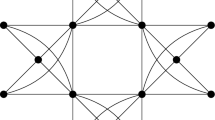Abstract
We show that the Gaussian primesP[i] ⊆ ℤ[i] contain infinitely constellations of any prescribed shape and orientation. More precisely, we show that given any distinct Gaussian integersv 0,…,v k−1, there are infinitely many sets {a+rv 0,…,rv k−1}, witha ∈ℤ[i] andr ∈ℤ{0}, all of whose elements are Gaussian primes.
The proof is modeled on that in [9] and requires three ingredients. The first is a hypergraph removal lemma of Gowers and Rödl-Skokan or, more precisely, a slight strenghthening of this lemma which can be found in [22]; this hypergraph removal lemma can be thought of as a generalization of the Szemerédi-Furstenberg-Katznelson theorem concerning multidimensional arithmetic progressions. The second ingredient is the transference argument from [9], which allows one to extend this hypergraph removal lemma to a relative version, weighted by a pseudorandom measure. The third ingredient is a Goldston-Yildirim type analysis for the Gaussian integers, similar to that in [9], which yields a pseudorandom measure. which is concentrated on Gaussian “almost primes”.
Similar content being viewed by others
References
P. Frankl and V. Rödl,Extremal problems on set systems, Random Struct. Algorithms20 (2002), 131–164.
H. Furstenberg and Y. Katznelson,An ergodic Szemerédi theorem for commuting transformations. J. Analyse Math.34 (1978), 275–291.
H. Furstenberg and Y. Katznelson,A density version of the Hales-Jewett theorem, J. Analyse Math.57 (1991), 64–119.
D. Goldston and C. Y. Yildirim,Higher correlations of divisor sums related to primes, I: Triple correlations, Integers3 (2003) A5, 66pp.
D. Goldston and C. Y. Yildirim,Higher correlations of divisor sums related to primes, III: k-correlations, preprint (available at AIM preprints).
D. Goldston and C. Y. Yildirim,Small gaps between primes, I, preprint.
T. Gowers,A new proof of Szemeredi's theorem, GAFA11 (2001), 465–588.
T. Gowers,Hypergraph regularity and the multidimensional Szemerédi theorem, preprint.
B. Green and T. Tao,The primes contain arbitrarily long arithmetic progressions, preprint.
G. H. Hardy and E. M. Wright,An Introduction to the Theory of Numbers, 5th Ed., Oxford, Clarendon Press, 1979.
Y. Kohayakawa, V. Rödl and J. Skokan,Hypergraphs, quasi-randomness, and conditions for regularity, J. Combin. Theory Ser. A97 (2002), no. 2, 307–352.
B. Nagle, V. Rödl and J. Skokan,The counting lemma for regular k-uniform hypergraphs, Random Structures and Algorithms, to appear.
J. Renze, S. Wagon and B. Wick,The Gaussian Zoo, Experimental Math.10 (2001) 161–173.
V. Rödl and J. Skokan,Regularity lemma for k-uniform hypergraphs, Random Structures and Algorithms,25 (2004), 1–42.
V. Rödl and J. Skokan,Applications of the regularity lemma for uniform hypergraphs, preprint.
I. Ruzsa and E. Szemerédi,Triple systems with no six points carrying three triangles, Colloq. Math. Soc. J. Bolyai18 (1978), 939–945.
J. Solymosi,Note on a generalization of Roth's theorem, Discrete and computational geometry, Algorithms Combin.25, Springer Verlag, 2003, pp. 825–827.
J. Solymosi,A note on a question of Erdös and Graham, Combinatorics, Probability and Computing13 (2004), 263–267.
E. Szemerédi,On sets of integers containing no four elements in arithmetic progression, Acta Math. Acad. Sci. Hungar.20 (1969), 89–104.
E. Szemerédi,On sets of integers containing no k elements in arithmetic progression, Acta Arith.27 (1975), 299–345.
T. Tao,A quantitative ergodic theory proof of Szemerédi's theorem, preprint.
T. Tao,A variant of the hypergraph removal lemma, preprint.
T. Tao,Arithmetic progressions in the primes, El Escorial conference proceedings.
T. Tao,A remark on Goldston-Yildirim correlation estimates, unpublished.
Author information
Authors and Affiliations
Rights and permissions
About this article
Cite this article
Tao, T. The Gaussian primes contain arbitrarily shaped constellations. J. Anal. Math. 99, 109–176 (2006). https://doi.org/10.1007/BF02789444
Received:
Issue Date:
DOI: https://doi.org/10.1007/BF02789444



